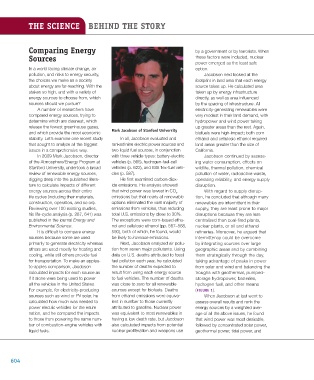Page 605 - Environment: The Science Behind the Stories
P. 605
tHE sCIENCE bEHINd tHE stoRy
Comparing Energy by a government or by terrorists. When
sources these factors were included, nuclear
power emerged as the least safe
In a world facing climate change, air option.
pollution, and risks to energy security, Jacobson next looked at the
the choices we make as a society footprint in land area that each energy
about energy are far-reaching. With the source takes up. He calculated area
stakes so high, and with a variety of taken up by energy infrastructure
energy sources to choose from, which directly, as well as area influenced
sources should we pursue? by the spacing of infrastructure. All
A number of researchers have electricity- generating renewables were
compared energy sources, trying to very modest in their land demand, with
determine which are cleanest, which hydropower and wind power taking
release the fewest greenhouse gases, up greater areas than the rest. Again,
and which provide the most economic Mark Jacobson of Stanford university biofuels were high-impact; both corn
stability. Let’s examine one recent study In all, Jacobson evaluated and ethanol and cellulosic ethanol required
that sought to analyze all the biggest ranked nine electric power sources and land areas greater than the size of
issues in a comprehensive way. two liquid fuel sources, in conjunction California.
In 2009 Mark Jacobson, director with three vehicle types: battery-electric Jacobson continued by assess-
of the Atmosphere/Energy Program at vehicles (p. 565), hydrogen-fuel-cell ing water consumption, effects on
Stanford University, undertook a broad vehicles (p. 622), and E85 flex-fuel vehi- wildlife, thermal pollution, chemical
review of renewable energy sources, cles (p. 587). pollution of water, radioactive waste,
digging deep into the published litera- He first examined carbon diox- operating reliability, and energy supply
ture to calculate impacts of different ide emissions. His analysis showed disruption.
energy sources across their entire that wind power was lowest in CO With regard to supply disrup-
2
life cycles (including their materials, emissions but that nearly all renewable tion, he concluded that although many
construction, operation, and so on). options eliminated the vast majority of renewables are intermittent in their
Reviewing over 100 existing studies, emissions from vehicles, thus reducing supply, they are least prone to major
his life-cycle analysis (p. 287, 641) was total U.S. emissions by close to 30%. disruptions because they are less
published in the journal Energy and The exceptions were corn-based etha- centralized than coal-fired plants,
Environmental Science. nol and cellulosic ethanol (pp. 587–588, nuclear plants, or oil and ethanol
It is difficult to compare energy 590), both of which, he found, would refineries. Moreover, he argued that
sources because some are used be likely to increase emissions. intermittency could be overcome
primarily to generate electricity whereas Next, Jacobson analyzed air pollu- by integrating sources over large
others are used mostly for heating and tion from seven major pollutants. Using geographic areas and by combining
cooling, while still others provide fuel data on U.S. deaths attributed to fossil them strategically through the day,
for transportation. To make an apples- fuel pollution each year, he calculated taking advantage of peaks in power
to-apples comparison, Jacobson the number of deaths expected to from solar and wind and balancing the
calculated impacts for each source as result from using each energy source troughs with geothermal, pumped-
if it alone were being used to power to fuel vehicles. The number of deaths storage hydropower, batteries,
all the vehicles in the United States. was close to zero for all renewable hydrogen fuel, and other means
For example, for electricity-producing sources except for biofuels. Deaths (Figure 1).
sources such as wind or PV solar, he from ethanol emissions were equiva- When Jacobson at last went to
calculated how much was needed to lent in number to those currently assess overall results and rank the
power electric vehicles for the entire attributed to gasoline. Nuclear power energy sources by a weighted aver-
nation, and he compared the impacts was equivalent to most renewables in age of all the above issues, he found
to those from powering the same num- having a low death rate, but Jacobson that wind power was most desirable,
ber of combustion-engine vehicles with also calculated impacts from potential followed by concentrated solar power,
liquid fuels. nuclear proliferation and weapons use geothermal power, tidal power, and
604
M21_WITH7428_05_SE_C21.indd 604 12/12/14 4:29 PM

